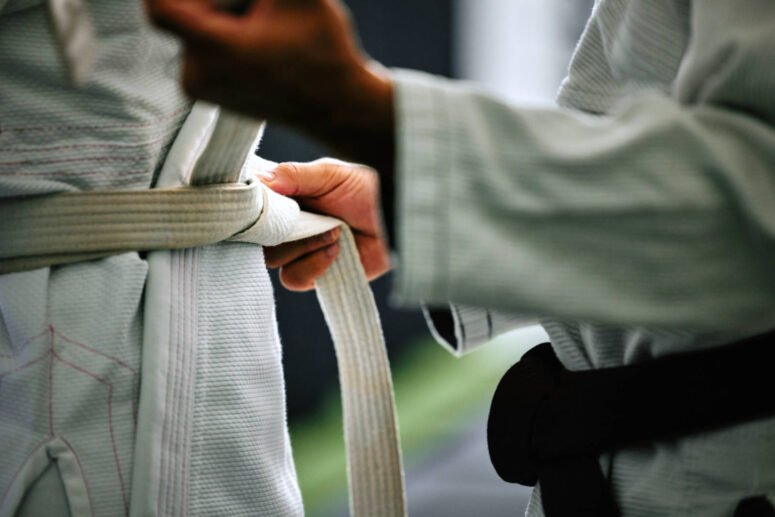
Stepping into the world of martial arts for the first time can feel both exciting and intimidating, but at EuljiKwan Hapkido Singapore, we’re here to guide you every step of the way. Whether you’re completely new to martial arts or transitioning from another discipline, such as taekwondo or judo, we believe Hapkido offers a fresh and enriching experience. Our classes, rooted in the authentic curriculum of the Korea Hapkido Federation, welcome beginners of all ages—from 7 to 77—ensuring you feel supported as you embark on a journey of self-defense, confidence, and personal growth.
What You Will Learn as a White Belt
As a white belt beginner, your Hapkido journey begins with building a strong foundation in practical self-defense techniques that prioritize safety and effectiveness. You’ll be introduced to five core Hapkido components: abdominal breathing, nakbup (breakfall), strikes, kicks, and grip releases. Here’s what each component entails and how it sets the stage for your growth in Hapkido.
Abdominal Breathing Methods – 4 Directions
Abdominal breathing is a fundamental exercise we practice after warming up, just before diving into technique training. These exercises not only improve blood and oxygen circulation but also strengthen vital areas like the forearms and abdomen, which are crucial for executing effective Hapkido techniques. This foundational practice enhances your focus, stamina, and overall physical readiness for training.
Nakbup (Breakfall)
Nakbup, or breakfall training, can be the most intimidating segment for beginners, but rest assured—we start simple to build your confidence. You’ll learn how to roll and breakfall from a kneeling position on foam mats, ensuring a safe introduction. Nakbup is an essential part of Hapkido, and without nakbup, you will not be able to fully learn and experience Hapkido techniques. It’s important not to give in to frustration, as consistent practice guarantees success. Mastering breakfalls helps you fall safely, reducing the risk of injury in both training and real-life scenarios.
Hand Strike Techniques – 4 Knifehand and 4 Elbow Strikes
Hapkido hand strikes go beyond basic punches, incorporating techniques like finger jabs, knife-hand strikes, and more. As a white belt, you’ll start with the knife-hand strike and progress to elbow strikes. While this may sound simple, an effective knife-hand strike relies on using your hips to generate force, rather than just your arm strength. The power of your body is always greater than the strength of your arms alone, and we’ll teach you how to harness it for maximum impact.
Kicks – 5 Techniques
While high kicks may look impressive in demonstrations, we focus on low kicks for their real-world applicability in self-defense. Low kicks, often targeting the shins, knees, or thighs, are difficult to counter and detect, giving you an advantage in challenging situations. They help you stay balanced and in control, disrupting an opponent’s stance without exposing you to unnecessary risk. In contrast, high kicks—though visually striking—can be easily blocked by an opponent’s hands, or worse, your leg could be grabbed, leaving you vulnerable. At EuljiKwan, we teach you to execute low kicks with precision and power, complemented by foundational skills like stances and leg movements.
Grip Releases – 5 Techniques
What’s the likelihood of someone grabbing you? Imagine a bully grabbing a victim’s shirt collar to intimidate, or an assailant pulling a woman’s hand to drag her away. While kicking an opponent is an option, what comes next? Should you escalate into a fistfight until someone is injured? We believe joint locking is the best way to de-escalate conflict, and it starts with mastering basic grip releases. If you can’t free your hand from an opponent’s grip, you won’t be able to execute joint locks effectively. At EuljiKwan, we train with strong grips to build real confidence—weak grips might let you escape easily, but they won’t teach you true skill. Your partner will grip your hand with real strength, and we’ll guide you on how to release it with minimal effort.
These skills not only equip you for self-defense but also lay the groundwork for your progression through the belt ranks, ensuring a safe and rewarding learning experience.
Why Start Your Journey with Us?
Our white belt curriculum is designed to build confidence and competence from day one, whether you’re a child, teen, adult, or senior. Under the guidance of our instructor, you will train in a supportive environment that emphasizes proper technique, discipline, and enjoyment. We are excited to welcome you to our dojang—whether you choose our ActiveSG Bukit Canberra (Sembawang) or Pioneer location. We look forward to training with you!



